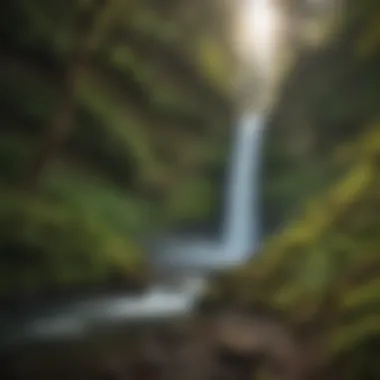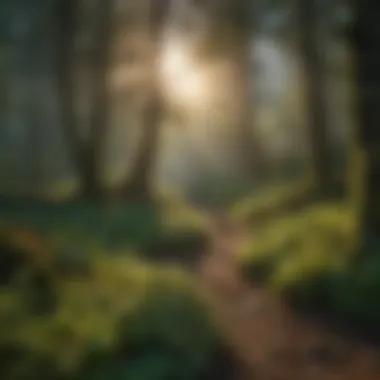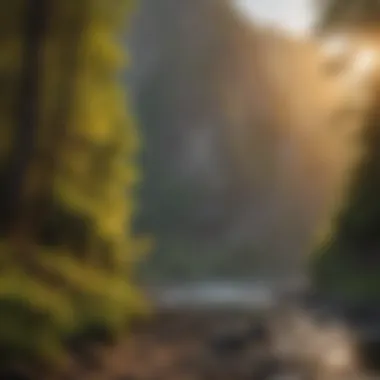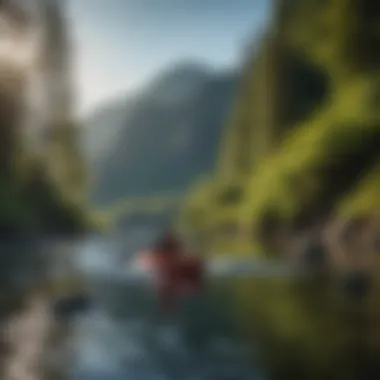Unveiling the Wonders of the Columbia River Gorge: A Natural Marvel


Evergreen Trees Species
In the vast expanse of the Columbia River Gorge, the evergreen trees stand tall and majestic, showcasing a diverse array of species that contribute to the region's rich ecological tapestry. From the iconic Douglas fir to the resilient Western red cedar, these trees not only provide natural beauty but also play a crucial role in sustaining the delicate balance of the ecosystem. The lush coniferous forests of the Gorge harboring these evergreen giants serve as a haven for wildlife, offering shelter, food, and nesting grounds for a myriad of species.
Types of Evergreen Trees
Within the verdant landscapes of the Columbia River Gorge, a symphony of evergreen tree species flourishes, each with its unique characteristics and adaptations. Visitors can encounter the towering presence of the ponderosa pine, with its distinctive bark and fragrant scent, or marvel at the grandeur of the noble fir standing sentinel in the forest understory. Additionally, the Western hemlock with its graceful drooping branches adds a touch of elegance to the woodland scenery, while the robust Sitka spruce thrives along the riverbanks, enhancing the Gorge's diverse flora.
Ecological Significance
The ecological significance of evergreen trees within the Columbia River Gorge cannot be overstated. These trees act as primary producers, converting sunlight into energy through photosynthesis and sustaining a complex web of life within the ecosystem. Their year-round greenery provides essential habitat and food sources for numerous wildlife species, contributing to the overall biodiversity of the region. Furthermore, evergreen trees play a crucial role in nutrient cycling, soil stabilization, and watershed protection, making them indispensable components of a healthy and resilient environment.
Conservation Practices
To ensure the preservation of evergreen tree species in the Columbia River Gorge, dedicated conservation practices are imperative. Implementing sustainable land management strategies, such as selective logging and reforestation efforts, helps maintain the balance between human needs and ecological integrity. Collaboration between community stakeholders, governmental agencies, and environmental organizations is vital in promoting responsible stewardship of these invaluable resources. By prioritizing conservation practices that prioritize long-term forest health and biodiversity, we can safeguard the legacy of evergreen forests for future generations to cherish and enjoy.
Introduction
Overview of the Columbia River Gorge
The geographical location of the Columbia River Gorge serves as a pivotal point in understanding its essence. Situated between Oregon and Washington, this gorge stands out for its strategic placement, where the Columbia River carves through the Cascade Range, creating a natural boundary of awe-inspiring cliffs and valleys. The significance of this geological formation as a natural wonder stems from its unmatched beauty, diverse ecosystems, and historical importance, making it a prime destination for explorers seeking both natural and cultural enrichment. The unique feature of the Columbia River Gorge's location lies in its accessibility, attracting visitors with its breathtaking landscapes and various recreational activities.
In exploring the significance of the gorge as a natural wonder, its unparalleled beauty and natural diversity come to the forefront. Serving as a haven for plant and animal species, the gorge showcases nature's resilience and grandeur, accentuating the intrinsic value of preserving such delicate ecosystems. The key characteristic of the Columbia River Gorge as a natural wonder lies in its ability to captivate and inspire a sense of wonder, making it a valuable asset for environmental education and conservation efforts. The unique feature of the gorge's natural wonder status underscores its value as a sanctuary for both wildlife and human visitors, fostering a sense of connection to the natural world.
History and Formation
The formation of the Columbia River Gorge holds the key to unraveling its geological and cultural significance. From the cascading waters of the ancient Missoula Floods to the enduring presence of indigenous peoples, the gorge's creation represents a tapestry of natural forces and human influences. The key characteristic of the formation lies in its tumultuous past, shaped by volcanic activity and glacial movements, culminating in the breathtaking landscapes we witness today. The unique feature of the gorge's formation lies in its ability to narrate a story of resilience and adaptation, where nature and humanity have intertwined to create a harmonious landscape.
The indigenous peoples' connection to the gorge adds another layer of depth to its history, highlighting the long-standing relationship between Native American tribes and the land. Their intricate understanding of the gorge's ecosystems and resources showcases a deep respect for nature's gifts and the importance of living in harmony with the land. The key characteristic of this connection is the profound reverence indigenous communities hold for the gorge, viewing it not just as a physical landscape but as a spiritual realm intertwined with their cultural identity. The unique feature of this connection underscores the need to honor and preserve the traditions and knowledge passed down through generations, safeguarding the cultural heritage embedded in the gorge's rocky walls.
The impact of European exploration and settlement in the region has left enduring marks on the Columbia River Gorge, shaping its development and perception over time. From early expeditions to industrialization, the influx of European settlers introduced new dynamics to the landscape, altering traditional land use patterns and ecological balance. The key characteristic of European exploration lies in its transformative effect on the gorge, leading to changes in land management, resource utilization, and cultural practices. The unique feature of this impact emphasizes the importance of understanding the legacy of colonization and its ongoing implications for conservation efforts and indigenous rights in the region.


Geology and Geography
The geology of the Columbia River Gorge unveils a tapestry of ancient forces and geological processes that have sculpted its rugged terrain. From basalt cliffs to lush forests, the gorge's diverse landscapes reflect a history of volcanic activity, erosion, and ecological evolution. The key characteristic of the geological makeup lies in its complexity, with layers of basalt revealing the story of ancient lava flows and the immense forces that shaped the region. The unique feature of the gorge's geology lies in its ability to showcase both ancient and ongoing geological processes, providing a living laboratory for geological research and education.
The impact of the Missoula Floods on the Columbia River Gorge stands as a testament to the region's dynamic history, where catastrophic floods sculpted the landscape and left indelible marks on its geography. The key characteristic of this impact lies in the massive scale of the floods, which reshaped the gorge's topography and influenced its ecological diversity. The unique feature of the Missoula Floods lies in their role as key drivers of landscape formation, highlighting the power of natural disasters to shape and rejuvenate ecosystems over time. Understanding the legacy of these floods is crucial in appreciating the ever-changing nature of the gorge and its resilience in the face of elemental forces.
The unique geological features of the Columbia River Gorge add a layer of intricacy to its allure, showcasing a mosaic of cliffs, waterfalls, and rock formations that defy conventional descriptions. From the iconic Multnomah Falls to the towering walls of the basalt cliffs, these features mark the gorge as a geological wonderland, inviting exploration and contemplation. The key characteristic of these geological wonders lies in their diversity and complexity, offering insights into the region's geological history and environmental dynamics. The unique feature of these geological landmarks lies in their capacity to inspire wonder and curiosity, prompting further inquiry and appreciation for the forces of nature at play in shaping the gorge's remarkable landscapes.
Flora and Fauna
Flora and fauna play a pivotal role in the intricate ecosystem of the Columbia River Gorge, adding layers of biodiversity and natural charm to this scenic landscape. The flora, consisting of a rich variety of plant species, contributes significantly to the visual appeal and ecological balance of the region. Similarly, the diverse fauna inhabiting the gorge not only enhances its allure but also indicates the overall health of the ecosystem. In this article, the exploration of flora and fauna sheds light on the interdependence of different species and their collective impact on the gorge's conservation and preservation.
Diverse Ecosystems
Variety of plant species in the gorge
Exploring the extensive range of plant species in the Columbia River Gorge uncovers a tapestry of botanical diversity that flourishes in various microclimates. The prevalence of plant species such as Douglas fir, Oregon white oak, and bigleaf maple contributes to the lush greenery and forested areas that define the gorge's landscape. These plants not only provide habitats for wildlife but also offer essential resources like food and shelter. Understanding the variety of plant species in the gorge enhances our appreciation for nature's intricate patterns and the symbiotic relationships within the ecosystem.
Wildlife habitats and species diversity
The wildlife habitats within the Columbia River Gorge provide sanctuaries for a myriad of animal species ranging from elk and black bears to diverse bird populations. The coexistence of these creatures highlights the interconnectedness of the ecosystem and the importance of preserving habitat diversity. The species diversity, from small rodents to apex predators, creates a balanced ecosystem where each organism plays a crucial role. Thus, delving into the wildlife habitats and species diversity of the gorge offers a glimpse into the harmonious yet fragile balance of nature's intricacies.
Endemic Species
Rare and endangered species in the region
The presence of rare and endangered species in the Columbia River Gorge underscores the significance of conservation efforts in protecting biodiversity. Species such as the Northern spotted owl and Chinook salmon face threats due to habitat loss and climatic changes. Understanding the unique characteristics and habitats of these endemic species is essential for raising awareness about their conservation status and the need for proactive measures to ensure their survival. By showcasing the fragility of these species, this article aims to emphasize the urgency of conservation initiatives and community involvement in safeguarding these irreplaceable resources.
Conservation efforts
Amidst environmental challenges, various conservation efforts are underway to safeguard the delicate balance of the Columbia River Gorge's ecosystem. Collaborative projects involving local communities, conservation organizations, and government entities aim to address issues like invasive species, habitat degradation, and water pollution. By highlighting these conservation initiatives, we acknowledge the collective responsibility in preserving the natural heritage of the gorge for future generations. The tireless efforts to protect endemic species and restore habitats reflect a commitment to environmental stewardship and a sustainable future for the Columbia River Gorge.


Recreational Activities
Recreational activities play a pivotal role in unlocking the hidden treasures of the Columbia River Gorge. Exploring the diverse recreational possibilities not only offers a chance for adventure but also serves as a gateway to understanding and appreciating the natural charm of the region. Engaging in recreational endeavors within the gorge allows visitors to immerse themselves in its splendor while creating unforgettable memories that showcase the beauty and significance of this natural gem.
Hiking and Trails
Popular Hiking Trails in the Area
The Columbia River Gorge boasts an array of popular hiking trails that cater to various skill levels and interests, making it a prime destination for outdoor enthusiasts. One of the standout features of these trails is their accessibility, allowing individuals to embark on breathtaking journeys through lush landscapes and scenic vistas. The well-maintained paths offer a blend of challenges and rewards, ensuring hikers have a fulfilling experience that aligns with the essence of this article -- exploring the wonders of the gorge.
Scenic Viewpoints
The presence of scenic viewpoints in the Columbia River Gorge adds another layer of allure to the recreational offerings of the region. These viewpoints provide unparalleled opportunities to witness the grandeur of the gorge from different perspectives, heightening the overall experience for visitors. Each viewpoint presents a unique vantage point that showcases the beauty of the landscape, serving as a visual treat that encapsulates the essence of exploring this natural gem.
Water-based Activities
River Rafting and Kayaking Opportunities
Venturing into river rafting and kayaking activities within the Columbia River Gorge opens up a world of adventure and thrill for outdoor enthusiasts. These water-based activities not only allow individuals to interact with the gorge's natural elements but also provide a refreshing perspective on the region's beauty. The opportunity to navigate through the waterways presents a unique way to connect with the environment while experiencing the magic of the gorge firsthand.
Fishing Spots
For those seeking a more serene recreational experience, the fishing spots in the Columbia River Gorge offer a tranquil escape amidst nature's bounty. Anglers can indulge in the peaceful ambiance of the gorge while trying their luck at catching various fish species that inhabit the region's waters. These fishing spots not only cater to recreational interests but also highlight the harmony between human leisure activities and the gorge's ecological richness.
Scenic Drives and Lookouts
Scenic Routes for Road Trips
Embarking on scenic drives along carefully curated routes in the Columbia River Gorge is an enriching experience that affords travelers the opportunity to witness the region's beauty from the comfort of their vehicles. These routes not only offer convenience and accessibility but also present a leisurely way to explore the gorge's panoramic landscapes. The scenic drives become an integral part of the recreational activities, providing a comprehensive overview of the gorge's mesmerizing charm.
Noteworthy Viewpoints


Discovering the noteworthy viewpoints scattered throughout the Columbia River Gorge serves as a testament to the region's visual splendor. These viewpoints act as strategic locations where visitors can pause and admire the natural and geological wonders that define the gorge. Each noteworthy viewpoint encapsulates a piece of the gorge's narrative, creating a tapestry of sights that symbolize the beauty and allure of this natural gem.
Conservation and Preservation
In this segment of the article, the focus shifts towards the crucial aspects of conservation and preservation within the context of the Columbia River Gorge. Conservation and Preservation play a pivotal role in safeguarding the natural beauty and ecological integrity of this breathtaking region. By emphasizing the significance of responsible stewardship, the article aims to highlight the pressing need for environmental protection and sustainable practices. This section serves as a call to action for readers, urging them to appreciate and preserve the pristine landscapes of the Columbia River Gorge for future generations.
Challenges and Threats
Environmental threats to the gorge
Delving into the environmental threats facing the Columbia River Gorge reveals a myriad of challenges that jeopardize its delicate ecosystem. From pollution and deforestation to climate change impacts, the gorge faces numerous environmental stressors that require immediate attention. The unique biodiversity of the region is at risk due to these threats, underscoring the critical need for conservation efforts. By addressing these environmental challenges head-on, stakeholders can work towards mitigating their detrimental effects and ensuring the long-term sustainability of the gorge.
Human impact and urban development
The human footprint in the Columbia River Gorge extends beyond recreational activities, encompassing urban development and infrastructure projects that pose significant threats to its natural integrity. As population growth and urbanization encroach upon this pristine wilderness, the delicate balance between conservation and development is at stake. Balancing economic interests with environmental preservation presents a complex dilemma that necessitates careful planning and sustainable practices. Recognizing the impact of human actions on the gorge is essential in crafting effective conservation strategies that protect its ecological richness while accommodating human needs.
Conservation Efforts
Initiatives to protect the gorge
Efforts to protect the Columbia River Gorge involve a variety of initiatives aimed at preserving its natural heritage and enhancing ecosystem resilience. Conservation organizations, government agencies, and local communities collaborate on conservation projects that range from habitat restoration to establishing protected areas. These initiatives emphasize the importance of fostering a harmonious relationship between humans and nature, paving the way for sustainable coexistence in the gorge.
Collaborative conservation projects
Collaborative conservation projects bring together diverse stakeholders with a shared goal of conserving the Columbia River Gorge. By engaging in partnerships that transcend boundaries and disciplines, such projects promote holistic approaches to ecosystem management and biodiversity conservation. The collaborative nature of these initiatives underscores the collective responsibility of safeguarding the gorge's natural treasures for the benefit of present and future generations. Through collaborative efforts, stakeholders can leverage their expertise and resources to address conservation challenges effectively and foster a culture of environmental stewardship.
Conclusion
In concluding this exploration of the Columbia River Gorge, it becomes evident that the preservation of natural landscapes holds exceptional significance. As nature's splendor unfolds within the expansive canyon spanning two states, the responsibility to protect and conserve it becomes paramount. The Columbia River Gorge stands as a testament to the beauty and diversity of the natural world, offering both locals and visitors opportunities to engage with a unique ecosystem. By promoting conservation efforts and sustainable practices, we can ensure that future generations continue to appreciate and benefit from this natural gem.
Appreciating Nature's Splendor
Importance of Preserving Natural Landscapes
The importance of preserving natural landscapes lies in the inherent value they provide to both the environment and human well-being. Conservation efforts aimed at protecting these landscapes contribute significantly to the overall health of ecosystems and biodiversity. Preserving natural landscapes not only safeguards habitats for various species but also helps mitigate the effects of climate change by maintaining balanced ecosystems. In the context of this article, emphasizing the significance of preserving natural landscapes serves as a reminder of our interconnectedness with the environment and the need to act as stewards of these precious resources.
Encouraging Responsible Tourism
Encouraging responsible tourism within the Columbia River Gorge is vital for maintaining the delicate balance between visitor enjoyment and conservation. By promoting sustainable travel practices such as minimizing waste, respecting wildlife habitats, and supporting local conservation initiatives, responsible tourism enhances the long-term viability of eco-tourism destinations. The Columbia River Gorge, with its awe-inspiring landscapes and rich biodiversity, presents an opportunity to showcase the benefits of responsible tourism. By fostering a culture of environmental responsibility among tourists, we not only protect the natural splendor of the gorge but also create a sustainable model for future tourism development in similar pristine environments.



